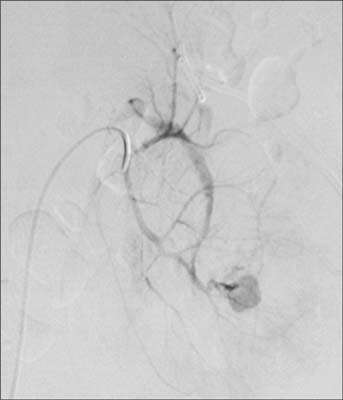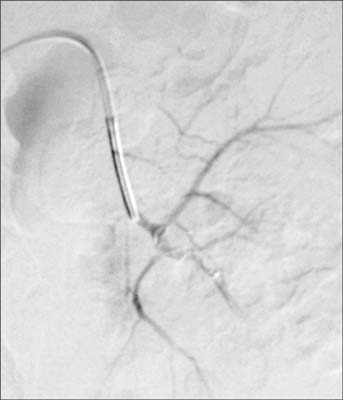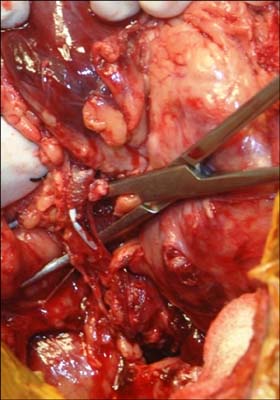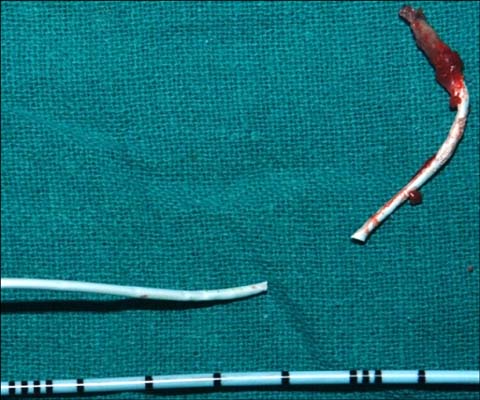Korean J Urol.
2014 Jun;55(6):426-429. 10.4111/kju.2014.55.6.426.
Glued Angiocatheter: A Rare Complication of Intrarenal Pseudoaneurysm Glue Angioembolization
- Affiliations
-
- 1Post Graduate Institute of Medical Education & Research, Chandigarh, India. varunvats298@gmail.com
- KMID: 1885623
- DOI: http://doi.org/10.4111/kju.2014.55.6.426
Abstract
- Endovascular management of intraparenchymal renal artery pseudoaneurysms is a reasonable and effective therapeutic technique. Endovascular management preserves the maximum amount of renal tissue and reduces the potential risk of nephrectomy. We present the case of an angiocatheter that became stuck in the renal artery following the injection of cyanoacrylate glue for angioembolization of an intrarenal pseudoaneurysm.
MeSH Terms
Figure
Reference
-
1. Sampaio FJ, Aragao AH. Anatomical relationship between the intrarenal arteries and the kidney collecting system. J Urol. 1990; 143:679–681.2. Massulo-Aguiar MF, Campos CM, Rodrigues-Netto N Jr. Intrarenal pseudoaneurysm after percutaneous nephrolithotomy. Angiotomographic assessment and endovascular management. Int Braz J Urol. 2006; 32:440–442.3. Okazaki M, Higashihara H, Koganemaru F, Ono H, Hoashi T, Kimura T. A coaxial catheter and steerable guidewire used to embolize branches of the splanchnic arteries. AJR Am J Roentgenol. 1990; 155:405–406.4. Davidson GS, Terbrugge KG. Histologic long-term follow-up after embolization with polyvinyl alcohol particles. AJNR Am J Neuroradiol. 1995; 16:4 Suppl. 843–846.5. Castaneda F, Goodwin SC, Swischuk JL, Wong GC, Bonilla SM, Wang MJ, et al. Treatment of pelvic arteriovenous malformations with ethylene vinyl alcohol copolymer (Onyx). J Vasc Interv Radiol. 2002; 13:513–516.6. Takebayashi S, Hosaka M, Kubota Y, Ishizuka E, Iwasaki A, Matsubara S. Transarterial embolization and ablation of renal arteriovenous malformations: efficacy and damages in 30 patients with long-term followup. J Urol. 1998; 159:696–701.7. Cantasdemir M, Adaletli I, Cebi D, Kantarci F, Selcuk ND, Numan F. Emergency endovascular embolization of traumatic intrarenal arterial pseudoaneurysms with N-butyl cyanoacrylate. Clin Radiol. 2003; 58:560–565.8. Lina JR, Jaques P, Mandell V. Aneurysm rupture secondary to transcatheter embolization. AJR Am J Roentgenol. 1979; 132:553–556.9. Beaujeux R, Saussine C, al-Fakir A, Boudjema K, Roy C, Jacqmin D, et al. Superselective endo-vascular treatment of renal vascular lesions. J Urol. 1995; 153:14–17.10. Yamakado K, Nakatsuka A, Tanaka N, Takano K, Matsumura K, Takeda K. Transcatheter arterial embolization of ruptured pseudoaneurysms with coils and n-butyl cyanoacrylate. J Vasc Interv Radiol. 2000; 11:66–72.
- Full Text Links
- Actions
-
Cited
- CITED
-
- Close
- Share
- Similar articles
-
- A Case of Pseudoaneurysm of the Supraorbital Artery Treated with Percutaneous Glue Embolization
- Pseudoaneurysm Formed by Slippage of Aneurysmal Clip
- Spontaneous Resolution of Pulmonary Artery Pseudoaneurysm after Tube Thoracostomy
- Intra-Aneurysmal Glue Embolisation of a Giant Pulmonary Artery Pseudoaneurysm after Left Upper Lobe Lobectomy: Case Report
- Delayed Splenic Pseudoaneurysm Formation after Angioembolization






